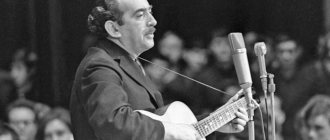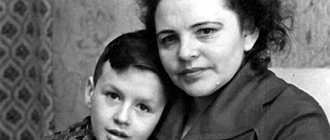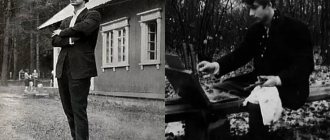Childhood and youth
Alexander Yaroslavich Nevsky was born in the city of Pereslavl-Zalessky. Yaroslav Vsevolodovich, Alexander’s father, was the Prince of Pereyaslavl at the time of his son’s birth, and later the Grand Duke of Kyiv and Vladimir. Rostislava Mstislavna, the mother of the famous commander - Princess of Toropets. Alexander had an older brother Fedor, who died at the age of 13, as well as younger brothers Andrei, Mikhail, Daniil, Konstantin, Yaroslav, Afanasy and Vasily. In addition, the future prince had sisters Maria and Ulyana.
Portrait of Alexander Nevsky
At the age of 4, the boy underwent the rite of initiation into warriors at the Spaso-Preobrazhensky Cathedral and became a prince. In 1230, his father put Alexander and his older brother in charge of Novgorod. But after 3 years, Fedor dies, and Alexander remains the only legal successor of the principality. In 1236, Yaroslav left for Kyiv, then to Vladimir, and the 15-year-old prince was left to rule Novgorod on his own.
First campaigns
The biography of Alexander Nevsky is closely connected with wars. Alexander took his first military campaign with his father to Dorpat with the goal of recapturing the city from the Livonians. The battle ended with the victory of the Novgorodians. Then the war for Smolensk with the Lithuanians began, victory in which remained with Alexander.
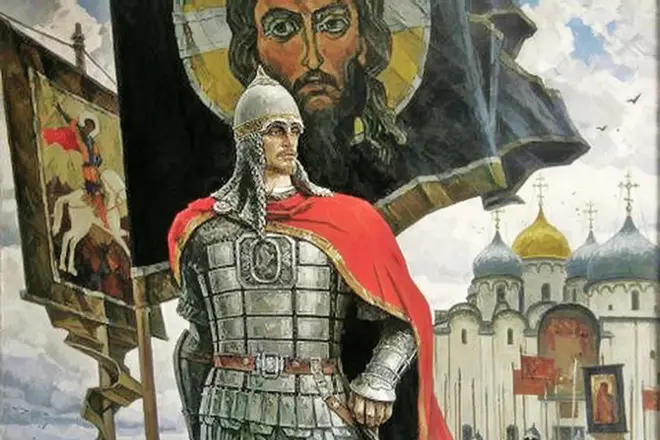
Alexander Nevsky on a military campaign
On July 15, 1240, the Battle of the Neva took place, significant in that Alexander’s troops, without the support of the main army, set up a Swede camp at the mouth of the Izhora River. But the Novgorod boyars were afraid of Alexander's increased influence. Representatives of the nobility, with the help of various tricks and incitements, ensured that the commander went to Vladimir to his father. At this time, the German army made a campaign against Rus', capturing the Pskov, Izborsk, and Vozh lands; the knights took the city of Koporye. The enemy army came close to Novgorod. Then the Novgorodians themselves began to beg the prince to return.
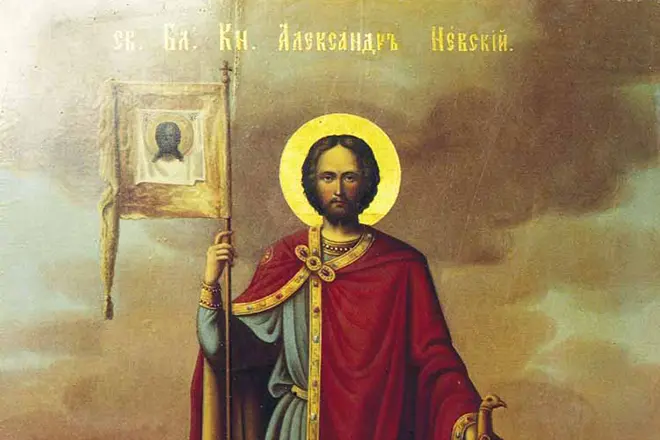
Icon of Alexander Nevsky
In 1241, Alexander Nevsky arrived in Novgorod, then liberated Pskov, and on April 5, 1242, the famous battle took place - the Battle of the Ice - on Lake Peipsi. The battle took place on a frozen lake. Prince Alexander used tactical cunning, luring knights dressed in heavy armor onto a thin layer of ice. The Russian cavalry attacking from the flanks completed the defeat of the invaders. After this battle, the knightly order abandoned all recent conquests, and part of Latgale also went to the Novgorodians.
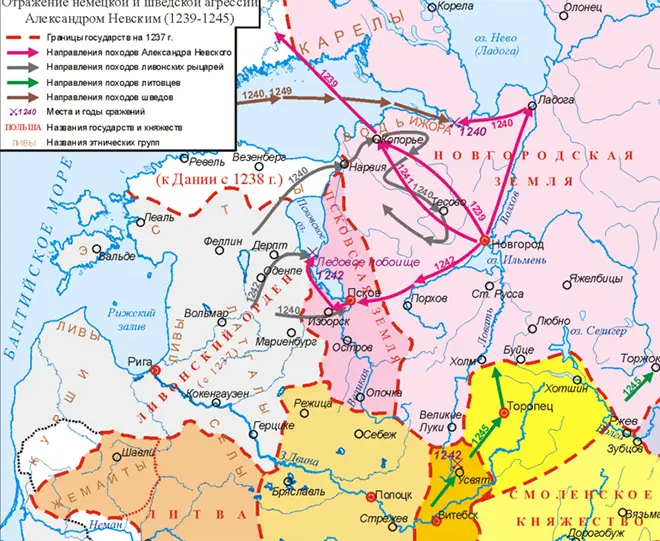
Map of the battles of Alexander Nevsky
After 3 years, Alexander liberated Torzhok, Toropets and Bezhetsk, captured by the army of the Grand Duchy of Lithuania. Then, solely with the help of his own army, without the support of the Novgorodians and Vladimirites, he caught up with and destroyed the remnants of the Lithuanian army, and on the way back he defeated another Lithuanian military formation near Usvyat.
Alexander Nevskiy. A tale of valor and courage
At the same time, the Novgorod boyars began to fear the growing influence of the young prince and, using various intrigues and incitements, achieved their goal: the brave young commander left Novgorod, going to Vladimir to his father.
Taking advantage of this moment, the German army began to gradually capture Rus', taking away the Pskov, Volga, and Izborsk lands, and then took the city of Koporye. And when they got close to Novgorod, the Novgorod nobles trembled, and they themselves began to ask the prince to return.
In 1241, Nevsky arrived in Novgorod and liberated Pskov. And on April 5, 1242, the historically significant and famous Battle of the Ice took place on Lake Peipsi.
Prince Alexander deliberately resorted to cunning, and when the lake froze, he lured the knights to the place where there was a thin layer of ice. And then the Russian cavalry, attacking from the flanks, completely completed the defeat of the enemy.
After this brilliant victory, the knightly order was forced to abandon the conquered territories and even cede part of Latgale.
And three years later, Prince Alexander Nevsky liberated the cities of Toropets, Torzhok and Bezhetsk from the troops of the Grand Duchy of Lithuania. Then, without the help of the Novgorodians and Vladimirites, on the way back he finished off the remnants of the Lithuanian army, and then another enemy formation near Usvyat.
Governing body
In 1247 Yaroslav died. Alexander Nevsky becomes Prince of Kyiv and All Rus'. But since Kyiv lost its strategic importance after the Tatar invasion, Alexander did not go there, but stayed to live in Novgorod.
In 1252, Andrei and Yaroslav, Alexander's brothers, opposed the Horde, but the Tatar invaders defeated the defenders of the Russian land. Yaroslav settled in Pskov, and Andrei was forced to flee to Sweden, so the Principality of Vladimir passed to Alexander. Immediately after this a new war followed with the Lithuanians and Teutons.
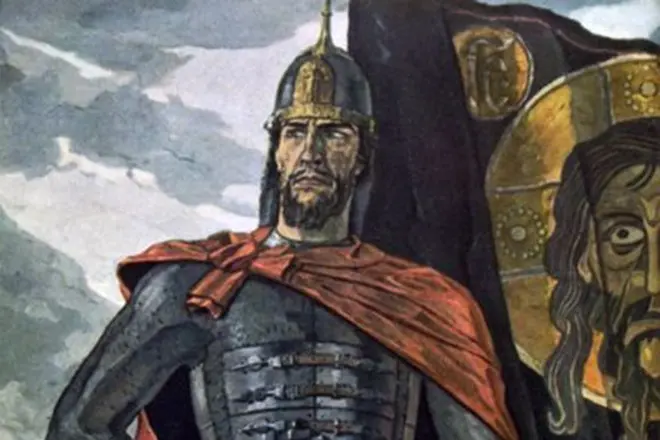
Prince Alexander Nevsky
The role of Alexander Nevsky in history is perceived ambiguously. The Novgorod prince constantly fought battles with Western troops, but at the same time bowed to the khan of the Golden Horde. The prince repeatedly traveled to the Mongol Empire to honor the ruler, especially supporting Batu and the Khan’s allies. In 1257, he even personally appeared in Novgorod with Tatar ambassadors to express support for the Horde.
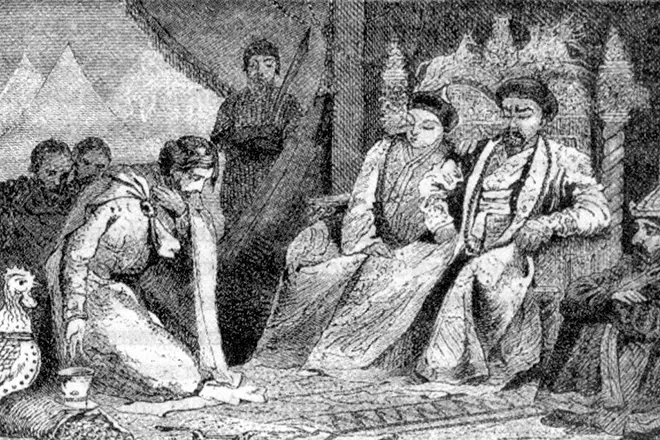
Alexander Nevsky in the tent of Khan Batu
In addition, Alexander exiled his son Vasily, who resisted the invasion of the Tatars, to the Suzdal land, and put 7-year-old Dmitry in his place. Such a policy of the prince in Russia itself is often called treacherous, since cooperation with the rulers of the Golden Horde suppressed the resistance of the Russian princes for many years to come. Many do not perceive Alexander as a politician, but they consider him an excellent warrior, and they do not forget his exploits.
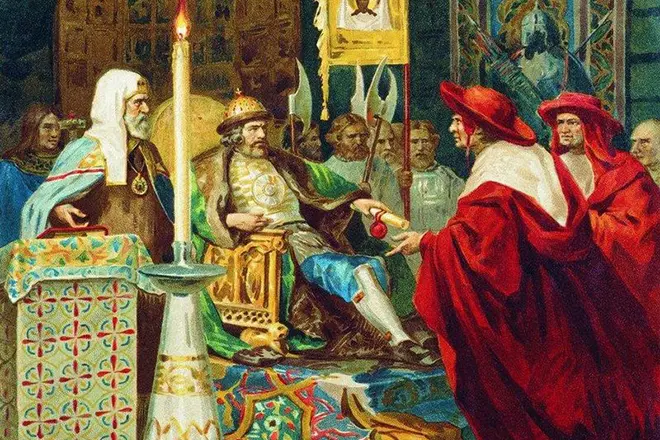
Prince Alexander Nevsky receives papal legates
In 1259, Alexander, with the help of threats of a Tatar invasion, obtained from the Novgorodians consent to a population census and payment of tribute to the Horde, which the Russian people resisted for many years. This is another fact from Nevsky’s biography that does not please the prince’s supporters.
Won his first battle at age 19
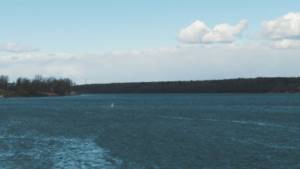
PHOTO by the author
In the 13th century, Rus' was surrounded by several powerful states. In the East, the Golden Horde of Khan Batu continued to plunder cities and destroy villages. In the West, the Pope dreamed of converting the Slavs to Catholicism and was preparing a crusade. In the North - Sweden, King Eric the Lisping attempted to destroy merchant ships.
In the summer of 1240, the Swedes decided to take control of the Neva - part of the route “from the Varangians to the Greeks.” An army of about 2,000 people crossed the borders of Novgorod's possessions and set up camp.
“The prince carefully analyzed possible ways of secretly approaching the Swedish camp,” says historian Roman Sokolov. “I took advantage of this initial plan and at dawn, with a sudden blow, during a bloody and rather long battle, I managed to defeat the Swedes.”
At that time, the prince was only 19 years old.
Battle on the Ice
At the end of August 1240, the crusaders of the Livonian Order invaded the Pskov land. After a short siege, the German knights captured Izborsk. Then the defenders of the Catholic faith besieged Pskov and occupied it with the assistance of the traitor boyars. This was followed by an invasion of Novgorod land.
At the call of Alexander Nevsky, troops from Vladimir and Suzdal arrived to help the Novgorodians under the command of Prince Andrey, the brother of the Novgorod ruler. The united Novgorod-Vladimir army launched a campaign against Pskov land and, cutting off the roads from Livonia to Pskov, took this city, as well as Izborsk, by storm.
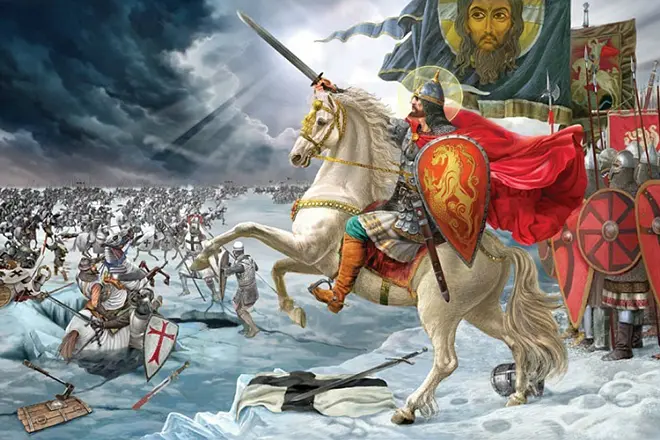
Prince Alexander Nevsky at the Battle of the Ice
After this defeat, the Livonian knights, having gathered a large army, marched to the Pskov and Peipsi lakes. The basis of the army of the Livonian Order was the heavily armed knightly cavalry, as well as infantry, which many times outnumbered the knights. In April 1242, a battle took place that went down in history as the Battle of the Ice.
For a long time, historians could not determine the exact location of the battle, because the hydrography of Lake Peipus often changed, but scientists later managed to indicate the coordinates of the battle on the map. Experts agreed that the Livonian Rhymed Chronicle more accurately describes the battle.
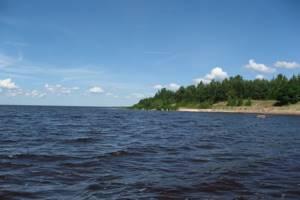
Lake Peipsi
The “Rhymed Chronicle” states that Novgorod had a large number of shooters who were the first to take the blow of the knights. The knights lined up in a “pig” - a deep column starting with a blunt wedge. This formation allowed the heavily armed knightly cavalry to deliver a ramming attack on the enemy line and break battle formations, but in this case such a strategy turned out to be wrong.
While the advanced detachments of the Livonians tried to break through the dense formation of the Novgorod infantry, the princely squads remained in place. Soon the vigilantes struck the enemy’s flanks, crushing and confusing the ranks of the German troops. The Novgorodians won a decisive victory.
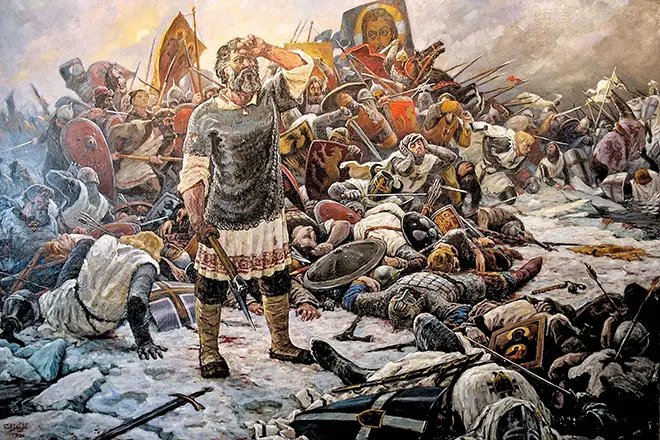
Battle of Lake Peipsi
Some historians claim that the knightly units consisted of 12-14 thousand soldiers, and the Novgorod militia numbered 15-16 thousand people. Other experts consider these figures to be exorbitantly high.
The result of the battle decided the outcome of the war. The Order made peace, abandoning the conquered Pskov and Novgorod territories. This battle played a huge role in history, influenced the development of the region, and preserved the freedom of the Novgorodians.
The exact location of the ice battle
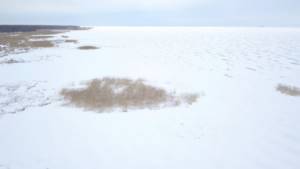
PHOTO by the author
Alexander Nevsky is known in history for two major battles. Battle of the Neva and Battle of the Ice. It took place in April 1242 on Lake Peipsi. In the Novgorod Chronicles there is a more precise place: “behind Uzmen, near the crow stone,” but for a long time historians did not know where this stone was located.
In 1962, the USSR Academy of Sciences organized an expedition to the Pskov region to find out the exact location of the battle. Historians worked for several seasons: they carried out excavations, studied chronicles and local legends. For example, we learned that the level of Lake Peipsi has risen by 2.5 meters in 800 years.
“The difficulty was precisely that it was impossible to initially find the crow stone, because everyone was looking for some kind of boulder, there are simply no such boulders, geologically they cannot exist,” says historian, expedition member Vladimir Potresov. “And in Russian dialects, the word “stone” is often understood as “rock” or “free-standing cliff,” which is what actually turned out to be.”
Now, with a 90% probability, we know the location of the Battle of the Ice.
Personal life
Alexander Nevsky married in 1239, immediately after the victory over the Lithuanians near Smolensk. The prince's wife was Alexandra, daughter of Bryachislav of Polotsk. The newlyweds got married in the Church of St. George in Toropets. A year later their son Vasily was born.
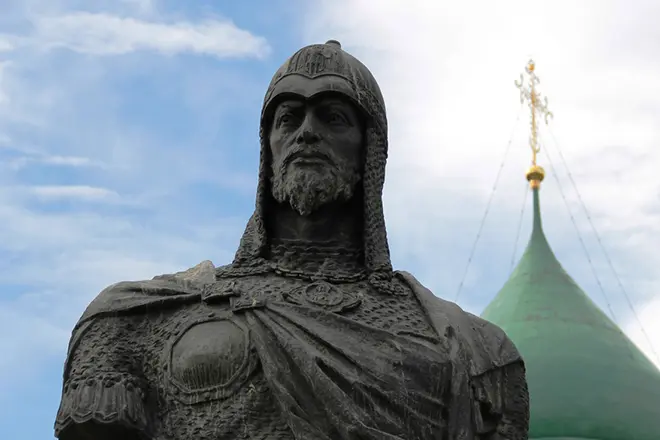
Monument to Alexander Nevsky
Later, the wife gave Alexander three more sons: Dmitry, the future prince of Novgorod, Pereyaslav and Vladimir, Andrei, who would be the prince of Kostroma, Vladimir, Novgorod and Gorodets, and Daniel, the first prince of Moscow. The princely couple also had a daughter, Evdokia, who later married Konstantin Rostislavich of Smolensk.
Death
In 1262, Alexander Nevsky went to the Horde to try to prevent the planned Tatar campaign. The new invasion was provoked by the murders of tribute collectors in Suzdal, Rostov, Pereyaslavl, Yaroslavl and Vladimir. In the Mongol Empire, the prince became seriously ill, and returned to Rus' already dying.
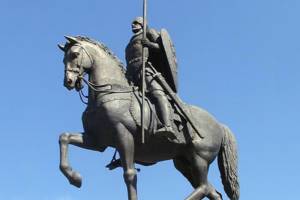
Monument to Alexander Nevsky
Upon returning home, Alexander Nevsky takes a solemn oath of Orthodox monks under the name Alexy. Thanks to this act, as well as due to the regular refusals of the Roman Papacy to accept Catholicism, Grand Duke Alexander became the favorite prince of the Russian clergy. Moreover, in 1543 he was canonized by the Russian Orthodox Church as a miracle worker.
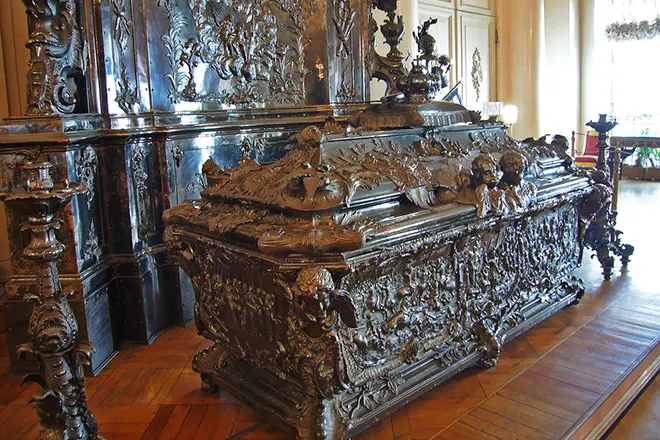
Sarcophagus of Alexander Nevsky
Alexander Nevsky died on November 14, 1263, and was buried in the Nativity Monastery in Vladimir. In 1724, Emperor Peter I ordered the relics of the holy prince to be reburied in the Alexander Nevsky Monastery in St. Petersburg. The monument to the prince was erected on Alexander Nevsky Square in front of the entrance to the Alexander Nevsky Lavra. This monument is presented in photographs in historical publications and magazines.
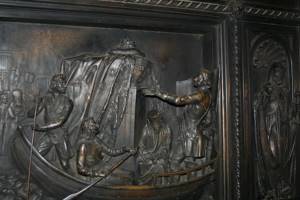
Peter I transports the relics of Alexander Nevsky to St. Petersburg. Relief on the door of St. Isaac's Cathedral
It is known that part of the relics of Alexander Nevsky is located in the Temple of Alexander Nevsky in Sofia (Bulgaria), as well as in the Assumption Cathedral of Vladimir. In 2011, the image with a particle of the relics was transferred to the Alexander Nevsky Church in the Ural village of Shurala. The icon of the Holy Blessed Prince Alexander Nevsky can often be found in Russian churches.
Death and legacy
Alexander Nevsky died on November 14, 1263 in Gorodets and was buried in the Nativity Monastery in the city of Vladimir. By order of Peter I, his relics were transferred to the Alexander Nevsky Monastery (St. Petersburg) in 1724.
Alexander Yaroslavich Nevsky plays an exceptional role in the history of Rus'. Throughout his entire life, Grand Duke Alexander Nevsky did not lose a single battle. He was considered the favorite prince of the clergy, the patron of the Orthodox Church. He can be briefly described as a talented diplomat, a commander who was able to protect Rus' from many enemies, as well as prevent the campaigns of the Mongol-Tatars.
Nowadays, streets and squares are named after him, monuments have been erected in his honor, and Orthodox churches have been erected in many cities of Russia.
Interesting Facts
- Prince Alexander won his main military victories in his youth. By the time of the Battle of the Neva, the commander was 20 years old, and during the Battle of the Ice the prince was 22 years old. Subsequently, Nevsky was considered a politician and diplomat, but more of a military leader. In his entire life, Prince Alexander did not lose a single battle.
- Alexander Nevsky is the only secular Orthodox ruler in all of Europe and Rus' who did not compromise with the Catholic Church in order to maintain power.
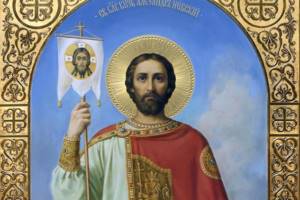
Icon of Alexander Nevsky
- After the death of the ruler, “The Tale of the Life and Courage of the Blessed and Grand Duke Alexander” appeared, a literary work of the hagiographic genre created in the 80s of the 13th century. It is assumed that the compilation of “The Life of Alexander Nevsky” was carried out in the Monastery of the Nativity of the Virgin Mary in Vladimir, where the prince’s body was buried.
- Feature films are often made about Alexander Nevsky. In 1938, the most famous film was released, called “Alexander Nevsky”. The director of the film was Sergei Eisenstein, and the cantata “Alexander Nevsky” was created for the choir and soloists with an orchestra by the Soviet composer Sergei Prokofiev.
- In 2008, the “Name of Russia” competition took place. The event was organized by representatives of the state TV channel “Russia” together with the Institute of Russian History of the Russian Academy of Sciences and the Public Opinion Foundation.
- Internet users chose the “Name of Russia” from a ready-made list of “five hundred great figures of the country.” As a result, the competition almost ended in scandal, because Joseph Stalin took the leading position. Organizers said that “numerous spammers” voted for the communist leader. As a result, Alexander Nevsky was named the official winner. According to many, it was the figure of the Novgorod prince that should have satisfied both the Orthodox community and Slavophile patriots, as well as simply lovers of Russian history.
Procession
Every year on September 12, a procession of the cross takes place in St. Petersburg in honor of the transfer of the relics of the holy noble prince Alexander Nevsky. Thousands of people with icons and replacements in their hands walk along the blocked Nevsky Prospekt.
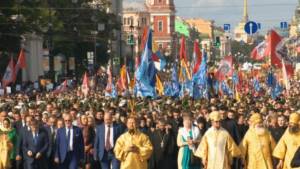
PHOTO by the author
“People come from Pskov, Novgorod, from different countries - Belarus, Ukraine, Finland. And the important thing is that in the Alexander Nevsky Lavra you can always, every single day, venerate the incorruptible relics of the Holy Blessed Grand Duke Alexander Nevsky,” says Hieromonk Procopius, assistant dean of the Holy Trinity Alexander Nevsky Lavra .


